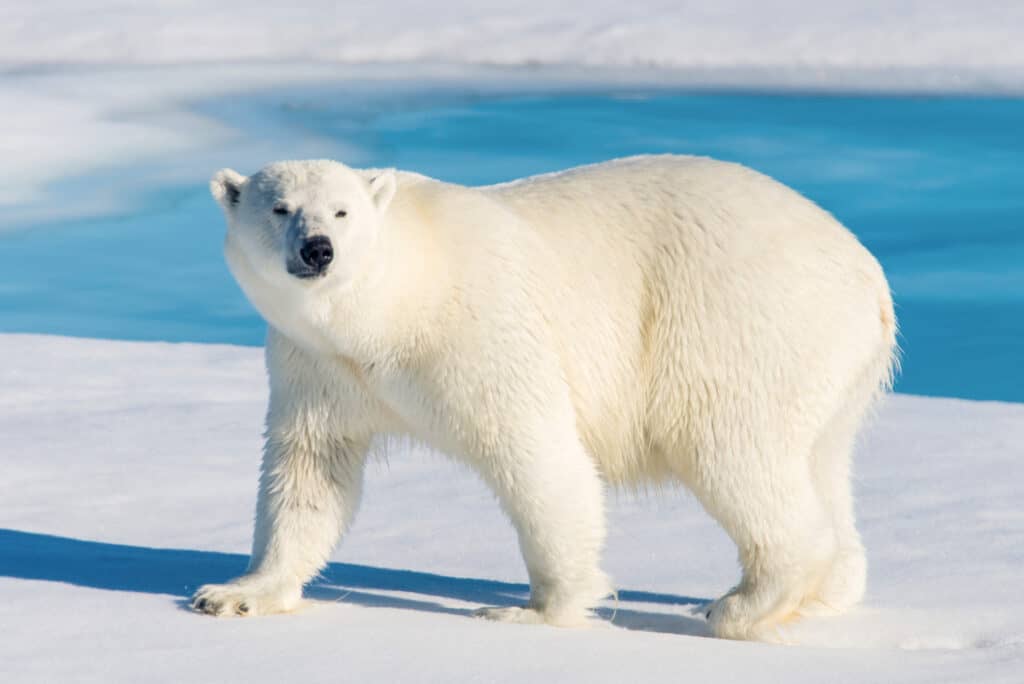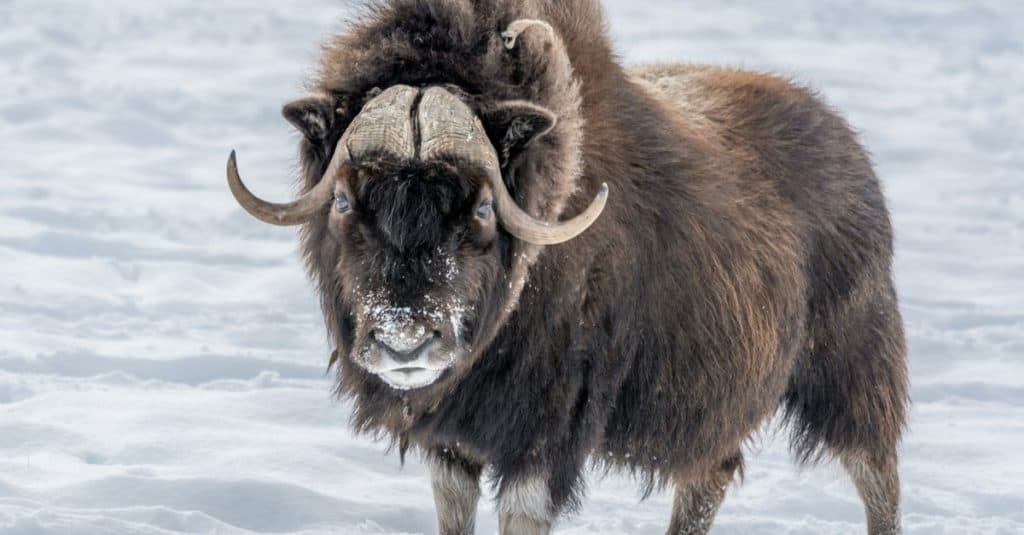Hundreds of animals inhabit the world’s coldest climates. From tiny penguins to large polar bears, these creatures must find ways to survive in the harshest environments of the planet. In this article, you’ll learn about seven prominent, Arctic animals that thrive in freezing weather beyond the already well-known reindeer. Let’s get started!
Polar Bear

Due to habitat loss, polar bears are extinct in some regions where they once thrived.
©iStock.com/Alexey_Seafarer
The polar bear inhabits one of the coldest places on the planet, the Arctic Circle. Still, although it is the world’s largest terrestrial carnivore, it is also one of the most vulnerable. This is because it depends on sea ice to hunt, give birth, and travel. As climate change warms the planet, sea ice melts, endangering the future of this species. In fact, polar bears are already extinct in some regions due to habitat loss.
There are reserves where polar bears can be protected from further damage. These reserves serve as a refuge for the species. They also allow scientists to study and learn more about this fantastic animal.
Emperor Penguin

Emperor penguins are a rare species.
©Joey_Danuphol/Shutterstock.com
Unlike the polar bear, the emperor penguin lives in Antarctica and is one of the rarest species. These penguins survive the cold thanks to their outer feathers. These feathers are covered with a layer of pure white, waterproof fat. In addition, they have a specialized arrangement of feathers that helps them adapt to harsh wind conditions.
Unfortunately, the emperor penguin is in danger of extinction due to human activity in Antarctica, such as overfishing and global warming. This species is an important part of the Antarctic ecosystem, and its loss would have drastic consequences.
Arctic Hare

With its thick fur, Arctic hares have adapted well to the Arctic tundra.
©Sophia Granchinho/Shutterstock.com
The Arctic hare is a well-adapted animal that can survive in the harsh climate of the Arctic tundra. It has thick, woolly fur that helps it stay warm in winter and feet with large pads that provide good traction in the snow.
The hare also has a small tail that it can use as a thermometer: if it is upright, the temperature is too cold for the hare to hibernate; if it is downward, the hare can begin its winter sleep. In summer, the hare feeds on plants, grasses, and herbs, but it may also feast on young willow leaves, which are rich in vitamin C.
Unlike many other hares, the arctic hare does not bury itself underground — instead, it sleeps in a small depression in the ground called a “form.” When it is time to sleep, the hare puts its fur over its head to keep warm. When awake, this animal usually stands on its hind legs to better see its surroundings. Without a doubt, the arctic hare is a fascinating animal that has adapted to life in one of the harshest environments on Earth.
Harp Seal

Because of their acute sense of hearing, harp seals prey on a number of fish species in the Atlantic and Arctic Oceans, where they are native.
©iStock.com/slowmotiongli
The harp seal is native to the northern Atlantic and Arctic Oceans, usually measuring only 2 to 3 feet in length and weighing between 50 and 100 pounds. These animals have a dark gray to black coat with a white underside that helps them withstand the coldest temperatures. In addition, they have very slender bodies with pointed snouts and small eyes.
They are solitary creatures that rarely gather in groups of more than two or three individuals. Also, they are excellent swimmers and can remain underwater for up to 20 minutes at a time. Harp seals feed mainly on cod, herring, and Greenland halibut, prey that they locate thanks to their acute sense of hearing, as Arctic waters are very dark.
Harp seals reach sexual maturity at about three years and have a lifespan of about 20 years. They are very vocal animals and use a variety of calls to communicate with each other. These seals are protected by the Convention on the Conservation of European Wildlife and Habitats and are considered endangered species.
Arctic Fox

As they help keep rodent numbers, the
Arctic fox
is integral to its ecosystem.
©iStock.com/MikeLane45
The Arctic fox is a small bushy-tailed mammal that, as its name suggests, lives in snow and ice. It has thick snow-white fur and greenish-blue eyes and lives in subway burrows, which it often digs itself. It also uses abandoned burrows made by other animals and feeds on small animals such as lemmings, voles, birds, fish, and eggs, although it may also eat insects and plant matter when it cannot find meat.
The Arctic fox is a prey animal that is hunted by predators such as wolves, bears, and humans. However, it also hunts for food, often catching small rodents such as rats and mice. The arctic fox is an integral part of its ecosystem, helping to keep rodent numbers down and playing a role in recycling nutrients in the environment.
Beluga Whale

At only 6 feet in length, the beluga whale is small for a whale.
©Luna Vandoorne/Shutterstock.com
The beluga whale, or white-sided dolphin, is a type of cetacean found in the colder waters of the Pacific Ocean. These animals are relatively small for whales, reaching a length of just about 6 feet (1.8 meters), and have an average weight of about 198 pounds (90 kilos). Their blue-gray skin coloration helps them camouflage in the water, and their sides are usually dotted with white spots. The beluga whale is a social animal that generally swims in groups of 3 to 12 individuals.
They are known for being extremely intelligent and have been observed to use sea sponges to protect their beaks while hunting. The beluga whale’s diet consists mainly of fish, but it occasionally consumes invertebrates such as squid. These animals are considered vulnerable to extinction due to human activities such as fishing and habitat destruction.
Musk Ox

Native to Arctic regions of Alaska, Canada, Greenland, and Siberia is the musk ox.
©Fitawoman/Shutterstock.com
The musk ox is a large Arctic ungulate related to the goat and cow, native to the Arctic regions of Alaska, Canada, Greenland, and Siberia. They are large, bulky animals with shaggy coats of hair and long, curved horns, and they are adapted to living in the harsh cold climate thanks to their thick fur. Musk oxen feed on grasses, sedges, and other plants and can withstand long periods of scarcity.
Although they are not currently threatened, human activity, such as hunting and climate change, has reduced their range and numbers. Musk oxen are important indicators of ecosystem health, and their conservation is vital to the Arctic.
Up Next:
- How Cold Is Too Cold For Dogs, And When Does It Get Dangerous?
- Discover The Venomous Arctic Snake That Survives -57° Bitter Cold
- How Do Sled Dogs Survive Such Intense Cold and Winter Storms?
The photo featured at the top of this post is © Blanka Berankova/Shutterstock.com
Sources
- British Broadcasting Corporation, Available here: https://www.bbc.co.uk/teach/teach/five-animals-that-can-survive-in-extremely-cold-weather/zmjfd6f
- Discover, Available here: https://www.discovermagazine.com/planet-earth/top-10-cold-weather-animals-and-how-they-thrive
- National Geographic, Available here: https://www.nationalgeographic.com/animals/article/polar-animals-in-antarctica-and-arctic
Thank you for reading! Have some feedback for us? Contact the AZ Animals editorial team.






